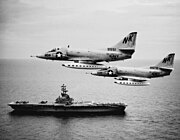Operation Pierce Arrow was a U.S. military operation during the Vietnam War.

A-4Cs from USS Constellation´s VA-146 a week after Operation Pierce Arrow.
In response to the Gulf of Tonkin Incident when the USS Maddox of the United States Navy engaged North Vietnamese ships, sustaining light damage[1] as it gathered electronic intelligence while in the international waters of the Gulf of Tonkin, U.S.President Lyndon B. Johnson ordered Operation "Pierce Arrow" which was conducted on August 5. The operation consisted of 64 strike sorties from the aircraft carriers Ticonderoga and Constellation against the torpedo boat bases of Hon Gai, Loc Chao, Quang Khe, and Ben Thuy, and the oil storage depot at Vinh. The U.S. lost two aircraft to anti-aircraft fire, with one pilot killed and another, Ensign Everett Alvarez Jr.[2] an A-4 Skyhawk pilot, becoming the first U.S. Prisoner of War in Vietnam. Pilots estimated they destroyed 90 percent of the petroleum storage facility at Vinh together with the destruction of or damage to 25 P-4 torpedo boats.
This was the start of U.S. air operations over North Vietnam and Southeast Asia, attempting to destroy the infrastructure, war material, and military units needed by North Vietnam to prosecute the guerrilla war in the South. Pierce Arrow was followed by Operation Flaming Dart on February 7–11, 1965; Operation Rolling Thunder from March 2, 1965 to October 31, 1968; Operation Linebacker, May 9 to October 22, 1972; and Operation Linebacker II, December 18–29, 1972.
Footnotes[]
- ↑ Tim Weiner, Legacy of Ashes: The History of the CIA (New York: Doubleday, 2007), p. 241.
- ↑ Interview with Everett Alvarez, 1981
The original article can be found at Operation Pierce Arrow and the edit history here.